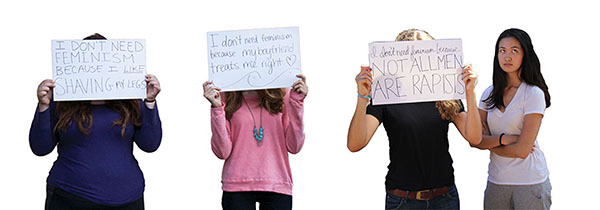Are you a feminist? Wait. Don’t click away just yet. It’s not as intimidating, exhausting and annoying as you may think.
Now let’s rephrase that question: Do you believe men and women should be treated equally?
If you responded “no” to the first question but “yes” to the second, then you are in fact a feminist. Regardless of gender.
There is a fundamental misunderstanding of feminism in our society and the recent internet phenomenon “Women Against Feminism” has brought the depth of the problem into focus. This movement consists of photos of women holding up signs explaining why they reject their idea of feminism. Although it was primarily rooted in a Tumblr page, “Women Against Feminism” has also branched out to Facebook and Twitter. The reasoning in these photos ranges from “I don’t need feminism because I am responsible for my actions” to “I am not a feminist because I like to shave my legs.”
Perhaps most telling of all is a woman smiling into the camera and holding a sign that reads “I don’t need feminism because fighting for women superiority is not fighting for equality.”
This statement reveals just how skewed the perception of feminism is. The fundamental principle behind feminism has always been that women deserve equality –– not superiority. Feminism is often mistakenly associated with misandry. Misandry is the “dislike of, contempt for, or ingrained prejudice against men,” according to the Oxford English Dictionary. Feminism, on the other hand, is “the advocacy of women’s rights on the grounds of political, social, and economic equality to men.”
It’s interesting how many Americans believe that women should receive equal pay and protection against sexual violence but still shun the term “feminism.” How did feminism become such a dirty word? Paly is a school set in a liberal community — a community with widespread acceptance of equal rights. Yet in a survey of Paly students1, only 56 percent of girls2 and 13 percent of boys3 responded “Yes” to the question “Do you consider yourself a feminist?”
If women are reluctant to identify as feminists, men are even more so. Emma Watson recognized this in her speech to the United Nations on Sept. 21 when she launched the HeForShe campaign.
“Gender equality is your issue, too,” Watson said, directly addressing men. “If men don’t have to be aggressive in order to be accepted, women won’t feel compelled to be submissive. If men don’t have to control, women won’t have to be controlled.”
Some of these women insist that the fight for equal rights is over. Indeed, women now do have opportunities that they couldn’t have imagined just a couple of decades ago — such as a greater variety of jobs, maternity leave and a furthered social independence from men. It wasn’t so very long ago that women in the U.S. did not even have the right to vote or own property. But keep in mind that it was feminists who pushed for those advancements. (With that said, the feminist movement of the 70s and 80s branded the word “feminism” negatively. Many people wrongly associate feminism with bra-burning extremists as a result.)
Even in the U.S., reform is far from complete. There still remains a significant pay gap between men and women in the same positions. Women make up 51 percent of the U.S. population and only 19 percent of Congress, according to the Rutgers Center for American Women and Politics.
In other countries, women are still denied the rights that many women in the U.S. take for granted. The Human Rights Watch states that in Saudi Arabia, girls and women are forbidden from traveling or undergoing certain medical procedures like abortion without permission from their male guardians or counterparts. In Yemen, women are only considered half a witness in a court of law, and they cannot leave the house without their husband’s permission, states the Washington Post. In Afghanistan, 85 percent of women reported experiencing domestic violence, states the Human Rights Watch.
In reality, the “Women Against Feminism” movement would be more aptly titled “Women Who Do Not Understand Feminism.” Here’s what the signs of “Women Against Feminism” would actually say: “I don’t need feminism because I believe that women are inferior to men. Males should have the right to dictate what happens to women’s bodies. Male superiority over women should be both accepted by society and enforced by law. Women should not have the power of choice.”
To the women who reject feminism because they love their husbands: consider yourselves lucky to have the right to choose who to marry. It’s wonderful to have a family and to care of that family. It’s wonderful to be a mother and be able to take care of the ones you love. Being a feminist doesn’t take these privileges away. Feminism is not intended to force you into the workplace. It’s the fight for women to have the choice to do so as much as men do, whether that choice is to stay at home or to run a company.
Let us say this: we’re thankful for the men and women who worked to give us the freedom and rights we have today and we are proud to be part of a movement that’s standing up for women in less privileged areas. We’re even thankful that “Women Against Feminism” exists because it has made clear the prevalent misconceptions in society about feminism. As for the women on the blog: we don’t demand that you embrace feminism. We only hope that you know what it really means before rejecting it.



